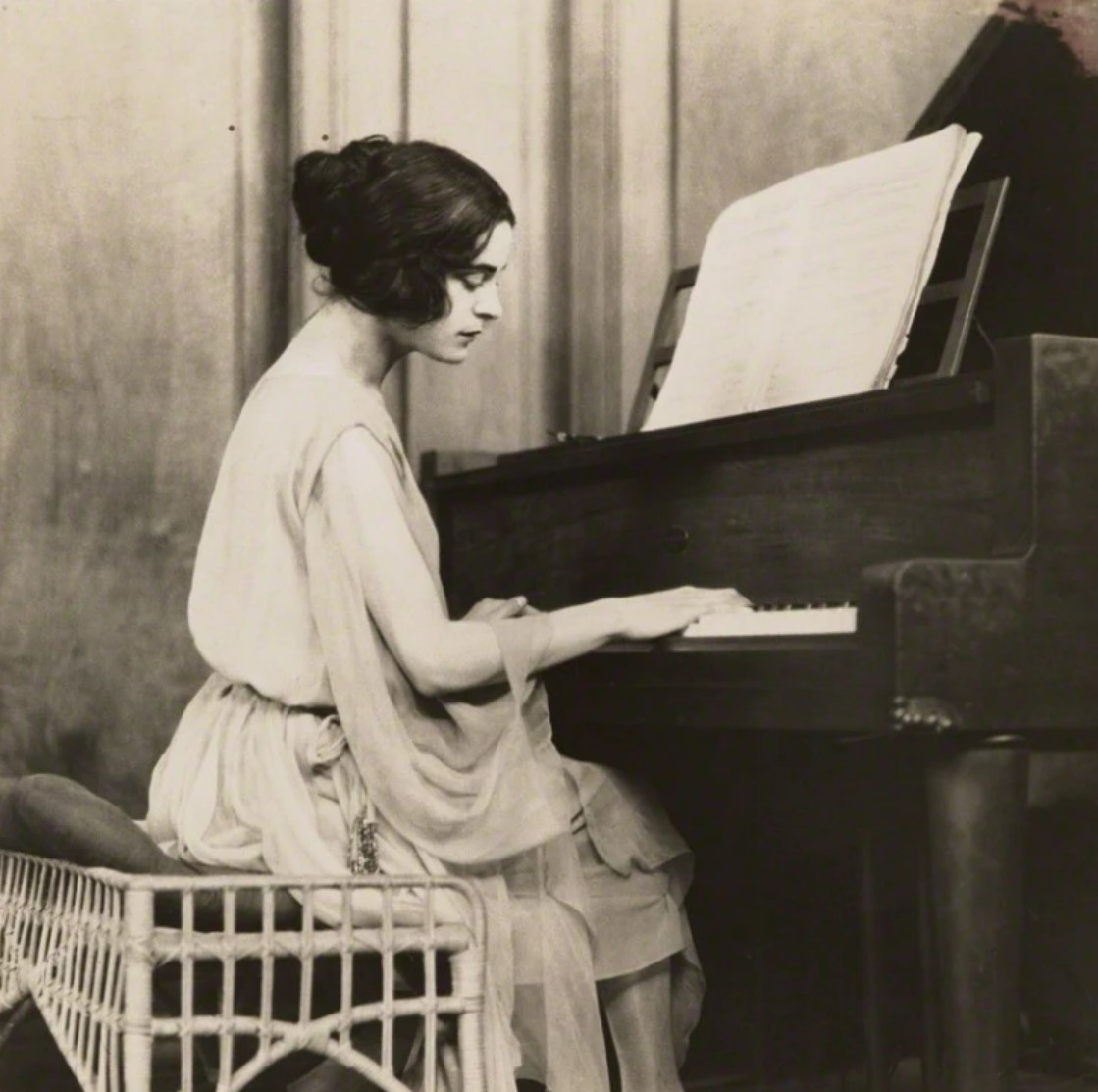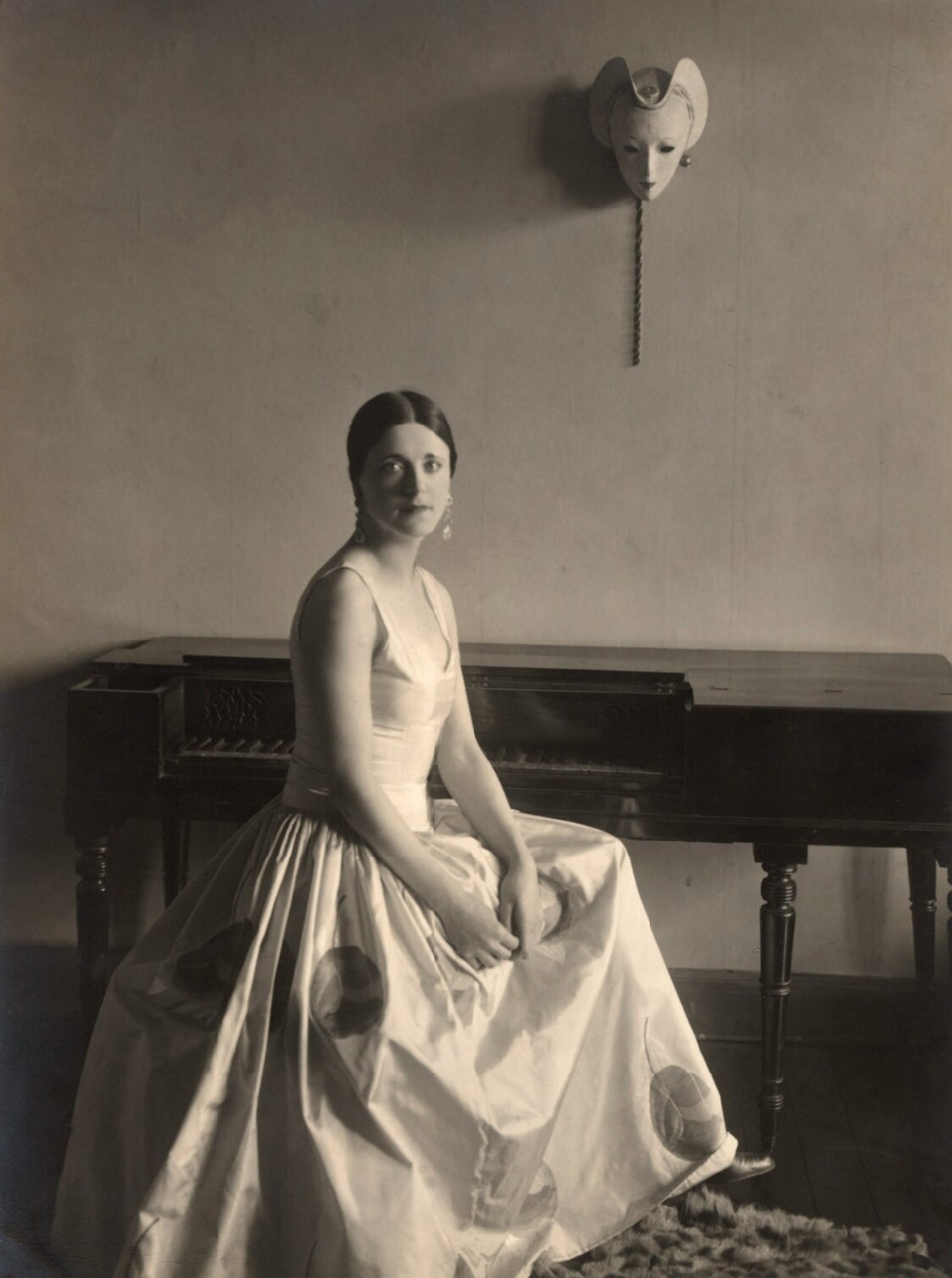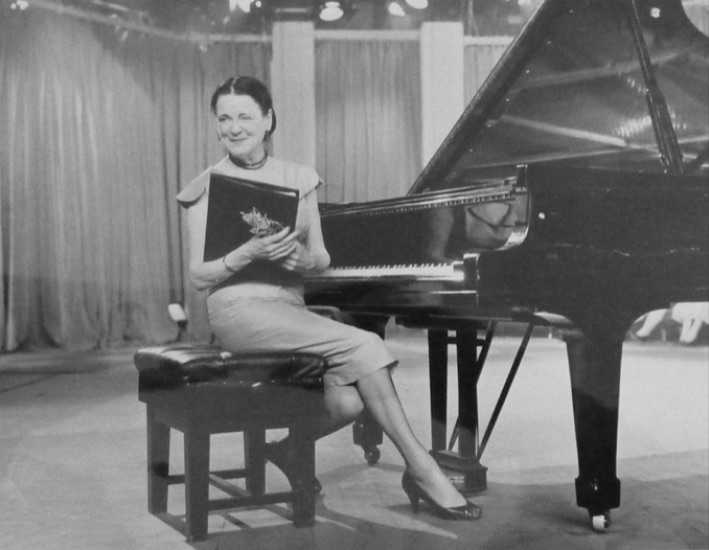Harriet Pearl Alice Cohen was born in London on 2 December 1895. We may have largely forgotten her today, but this little girl turned out to be one of the most important musicians of the twentieth century.
The Musical Childhood of Harriet Cohen

Harriet Cohen, ca 1921
Both of her parents were musical. Her father Joseph was a composer, and her mother Florence was a pianist who had studied under a renowned teacher named Tobias Matthay. Their social circle included many musicians, and Cohen later recalled that one of her first memories was “playing on Paderewski‘s knee in the artist’s room of the Queen’s Hall at the age of six.”
She inherited her parents’ musical talent, and when she was young, began studying piano at the Royal Academy of Music, also with Tobias Matthay. She won a variety of prestigious prizes during her time there.
She made her solo debut as a teenager, and her Wigmore Hall debut in 1920. It wasn’t long before she was regarded as an up-and-coming star of British music.
Cohen grew into an astonishingly beautiful woman, and she made full use of that beauty. She had a pre-performance ritual of bowing deeply to the audience and the conductor, then sitting down on the bench and removing her jewelry before nodding at the conductor and beginning.
Harriet Cohen’s Love Affair with Arnold Bax

Understandable, given her talent, beauty, and charm, Cohen’s love life was legendary. (After she died, a whole trunk of love letters was discovered.)
But through all of those relationships, the love of her life was composer Arnold Bax. In 1912, she met Bax for the first time. A couple of years later, she fell madly in love with him. He was 31 and married, with two children. She was nineteen.
In the autumn of 1916, during one of their illicit countryside trysts, they were caught in a torrential rainstorm, and ran into the woods for cover. This dramatic moment served as the inspiration for his cinematic tone poem November Woods.
Arnold Bax: November Woods (BBC Philharmonic Orchestra; Vernon Handley, cond.)
Eventually the pressure of a double life took its toll. Bax’s marriage ended in 1918. However, his wife refused to grant him a divorce, so Bax and Cohen weren’t able to marry, either. Not to mention, their relationship was under its own pressure, especially as Cohen’s performing career took off. He did, however, write almost all of his piano music for her.
How Harriet Cohen Inspired Contemporary Composers
The vivacious, self-effacing Cohen charmed every creative person she came in contact with. Her friends and collaborators were legendary.

• Ralph Vaughan Williams was besotted by her, and in one letter he referenced “a thousand kisses” that she owed him. He wrote his piano concerto for her, started in 1926 and finished in 1931. It was densely written, and public opinion about it was lukewarm, so he eventually rewrote it as a concerto for two pianos in the 1940s.
Ralph Vaughan Williams: Piano Concerto in C Major (Howard Shelley, piano; London Symphony Orchestra; Bryden Thomson, cond.)
• Nevertheless, Béla Bartók was impressed by Vaughan Williams’s concerto for Cohen. He ended up writing Six Dances in Bulgarian Rhythm from Mikrokosmos to her.
Béla Bartók: Mikrokosmos, BB 105, Vol. 6 – No. 148. Dance in Bulgarian Rhythm I (Dezső Ránki, piano)
Béla Bartók: Mikrokosmos, BB 105, Vol. 6 – No. 153. Dance in Bulgarian Rhythm VI (Dezső Ránki, piano)
• When she was a teenager, she met Edward Elgar at a party, and they became fast friends. She worked with him when recording his piano quintet in October 1933. It turned out to be one of the last projects he oversaw before his final illness and death.
Elgar Piano Quintet – Harriet Cohen/Stratton Quartet
• William Walton had her premiere his Sinfonia Concertante in 1927. Composer and pianist had a stormy but flirtatious relationship, but he admitted to her, “I know it will be in safe hands.”
William Walton: Sinfonia concertante (Peter Donohoe, piano; English Northern Philharmonia; Paul Daniel, cond.)
• She turned pages at the London premiere of Manuel de Falla’s Nights in the Gardens of Spain. De Falla was the soloist and asked for her feedback; she replied, “It’s much too fast and much too loud; they’re simply drowning you.” De Falla offered her the next British performance, which she played, but she wasn’t satisfied. So, with typical directness, she went to Granada to study it with him. It eventually became one of her signature pieces.
Manuel de Falla – Nights in the Gardens of Spain
At the end of her life, it was surmised that she may have given more premieres than any other pianist of her generation.
Harriet Cohen’s Baroque Music Advocacy
Her interests didn’t stop with contemporary composers, though. She was fascinated by English composers of the Elizabethan era: men like Byrd, Gibbons, and Purcell.
In fact, she was drawn to Baroque music in general. Bach became her calling card, and in 1925, she gave the first-ever all Bach recital at the Queen’s Hall in London.
Bach – Prelude & Fugue in E-flat minor, BWV 853 – Harriet Cohen
She gravitated toward this repertoire at least in part because of her small hands, which made the more outwardly virtuosic repertoire challenging. “I cannot normally cover more than eight notes with each hand,” she once reported.
Harriet Cohen’s Passion for Politics
Harriet Cohen also had political interests, and they became more pronounced in the turbulent 1930s.
In 1929, a man named Ramsay MacDonald became prime minister of Britain. Over the next few years, he struggled to address the era’s painful economic woes.
Despite a nearly thirty year age difference, it is believed that Cohen became MacDonald’s lover. At the very least, she was an extremely close confidant. She often visited him alone at 10 Downing Street and at his country house.
Harriet Cohen plays Brahms Intermezzo in B flat major, opus 76 no. 4
In 1930, while on tour in America, she met journalist and radio broadcaster Dorothy Thompson, who was one of the first American journalists to raise the alarm about the situation in Nazi Germany, and who famously interviewed Hitler himself in 1931. Cohen ended up serving as a conduit of information between Thompson and MacDonald.
In 1933 Cohen traveled to Vienna to give a series of concerts and to witness the political situation there first-hand, staying with Dorothy Thompson. She was deeply distressed by what she saw. The following year, Thompson would be expelled from Germany for her reporting.
Cohen began raising the alarm about the dangers facing German and Austrian Jews, and was upset about how few Jewish refugees were being allowed in America. To fundraise, she gave a joint concert with her friend Albert Einstein in America in 1934. He called her “the beloved piano witch.”
In 1939 she began advocating for a Jewish homeland. She survived two assassination attempts while in Palestine.
Harriet Cohen’s Soviet Tour
By this time, she had gained a reputation as a cultural ambassador. In 1935, she built on that reputation by touring in the Soviet Union. While there, she played not only English works, but contemporary Soviet ones by men like Shostakovich and Kabalevsky, thereby building a bridge between two different musical cultures.
She also brought some music back home with her. She ended up being the first musician outside of the Soviet Union to play Shostakovich’s Twenty-Four Preludes, which were written between 1932 and 1933.
24 Preludes, Op. 34: No. 14 in E-Flat Minor (Arr. H.R. Reynolds for Wind Ensemble)
She also served as vice-president of the Women’s Freedom League, an organization that, post-suffrage movement, worked to ensure the equal rights of women.
In 1938, after close to a decade of work in politics, Cohen was appointed a Commander of the Order of the British Empire (CBE).
The Return of Arnold Bax And a Tragic Betrayal
Although their relationship had its ups and downs, especially during her international travels in the 1930s, Bax and Cohen remained close enough that they traveled together to Finland to visit Jean Sibelius in 1936.
During this trip, Cohen teased Sibelius that she didn’t believe that his mysterious eighth symphony even existed – “it’s absolutely all rot; you’re just talking about it to get attention,” she said.
Sibelius responded by emptying out a box of cigarettes, and then writing out on the box’s cardboard the first chord of his mysterious eighth symphony. (Sadly, however, the manuscript for his eighth was eventually burned, and no one ever heard it.)
“He had a tremendous sense of humor,” Cohen remembered in a 1962 interview. “You could spend your whole day laughing with him.”
When Bax’s wife died in September 1947, Bax didn’t tell Cohen. In fact, Cohen only found out in May 1948, when the will was published.
Bax also chose that moment to drop a bombshell. He had another mistress, a woman named Mary Gleaves. And not only that, but they’d been together for over twenty years. He loved Gleaves, too, and couldn’t bring himself to marry Cohen. Cohen was devastated.
Days later, she had an accident with a tray of glasses that cut open an artery in her right hand, leaving her unable to use it for playing piano. Some have wondered if this was a cover story for self-harm, but we don’t know. Regardless, the effects of this injury lasted for years. Perhaps partly as an apology, Bax wrote a Concertino for Left Hand for Cohen.
Theme (From “Oliver Twist”)
Harriet Cohen’s Final Years
Cohen’s career was on the decline by this point. Although she eventually returned to the concert stage after her injury, her career never regained its earlier momentum.
Bax died in 1953, and he split his estate between Cohen and Gleaves. Vision trouble began plaguing Cohen, and she retired for good in 1960.
Harriet Cohen died on 13 November 1967. She will always be remembered for the incredible men and music that she inspired, but her astonishing talent and the fearless way she lived her life deserve to be remembered.
Here’s a charming interview she gave a few years before her death:
Harriet Cohen interview from 1962
For more of the best in classical music, sign up for our E-Newsletter
